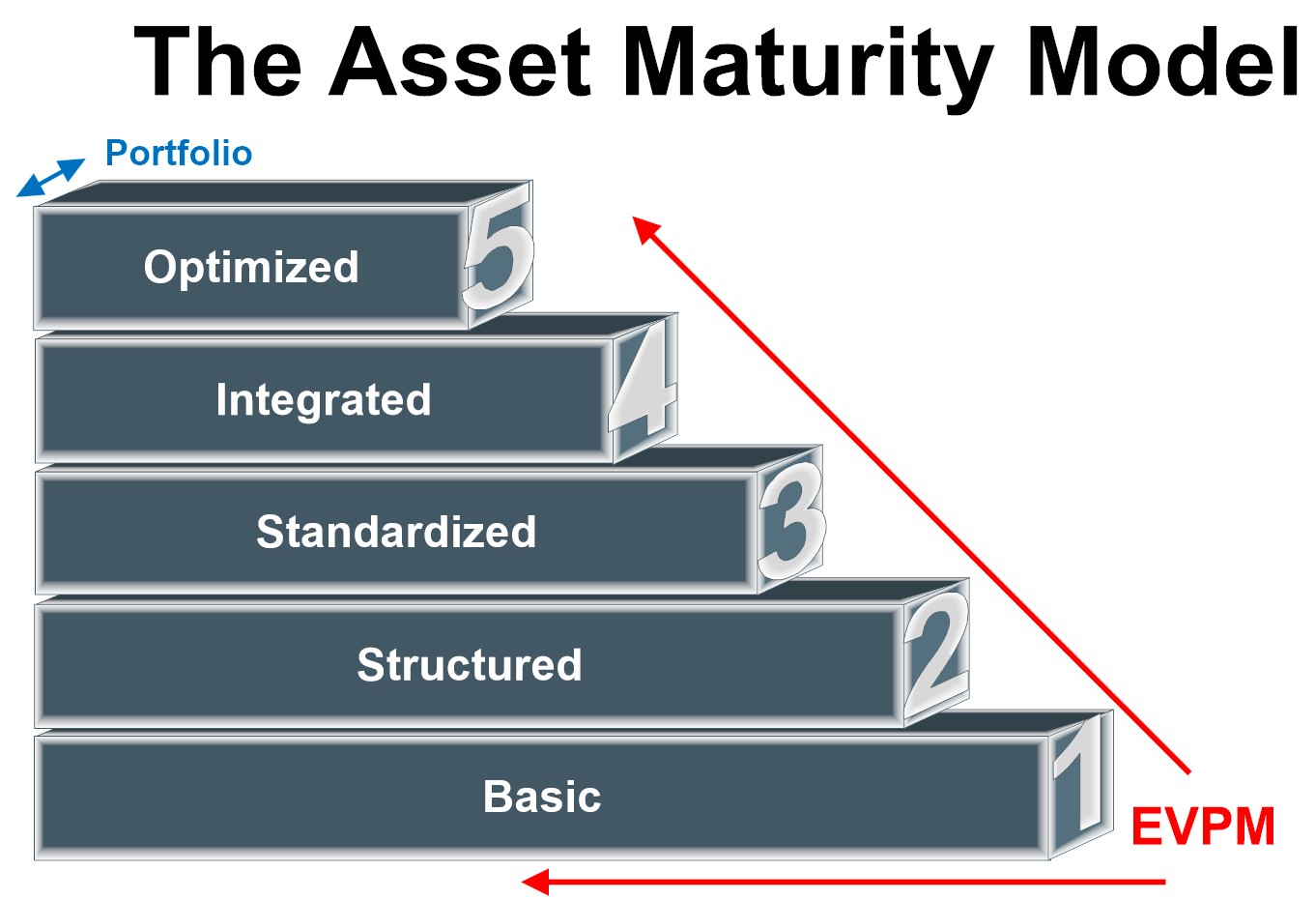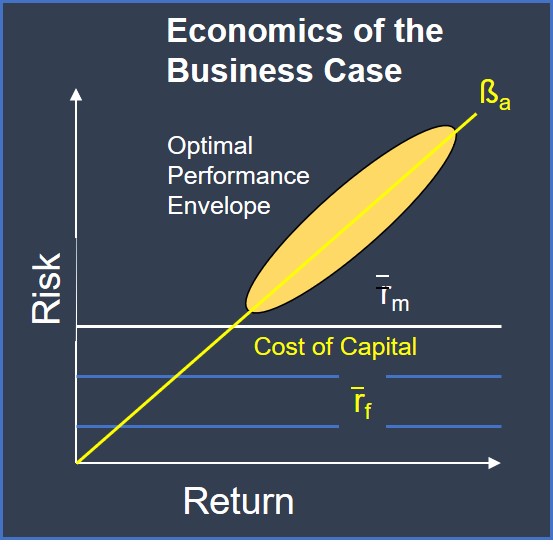
A Systemic Method of Managing Information Technology Investments in Portfolios of Revenue Producing Assets
Note: The Asset Maturity Model was originally developed for the Digital Oilfield–the original application of digital technologies to oil and gas extraction operations. However, it is applicable to most industrial asset portfolios undertaking the digitalization process.
Introduction
For a genereation of executives, terms such as continuous improvement or process improvement have been the imprimatur anointed by any number of management consultants.
The Asset Maturity Model was developed to help companies categorize both themselves and their various asset groups. The Asset Maturity Model is a five-stage econometric model that outlines a comprehensive methodology for categorizing producing assets and determining the ranges of appropriate IT technology that should likely be employed in managing those assets. It also provides the underlying concepts and methodology for making a reasoned business case for change in assets where addition IT investment is justified. Similar to most other industries that are embracing Six-Sigma manufacturing or production practices, digital asset management is becoming less asset and more digital. Timely and accurate information is more important to shareholder value than simple physical assets because only this type of information can optimize organizational performance.
New Horizons
Well over ninety percent of the daily production of the world’s energy is managed by legacy IT systems such as SCADA and process control systems. In many cases, these systems have been in place for decades and, like other investments and facilities that produce and transport energy, upgrades should be scrutinized with a focus on the economic benefits provided.
In the past, many investments in information technology (IT) were poorly understood, ill defined, and frequently suffered the failed end result of any project with these two deficiencies. Today however, IT is as mature as any other engineering technology, e.g. turbine engineering, etc. As such, it is simply a tool that, in the hands of a master craftsman, may produce a work of art but in the hands of a hack may actually damage what he or she sought to repair or enhance.
If the energy industry is becoming more organic (information-driven knowledge-based processes) rather than the mechanistic practices manifested throughout its history, then the decision making process will be different. Coupled with the real issues of how many new investment opportunities may or may not be forthcoming as well as whether current asset owners have the skills and cost structures required to maximize economic value, hard questions are looming.
Another major driver is demographics. Most are aware of the impending “Big Crew Change,” in the West as Baby Boomers begin retiring; however, there is another migratory process underway. The global energy industry continues to expand operations throughout the world and is hiring a broad range of individuals from all cultures. Knowledge that is currently largely in the hands of western-trained personnel must be transferred to a new heterogeneous generation.
The energy industry has always embraced large challenges head on. Current information technology offers a set of sophisticated tools that, selected and used properly, can make a direct economic contribution to energy providers and their supply chain partners.
The Asset Maturity Model
The Business Case for Digitalization
Investments in IT have been hard to justify and quantify. Business cases, often filled with soft benefits such as increased productivity are difficult to compare with other opportunities in the portfolio. Moreover, the IT track record is mixed and it has not been clear that firms with robust information based strategies have performed better than those that have not embraced these tools.

The typical portfolio of assets is a set of assets that span a variety of exposures or risks, differing performance, and dissimilar stages of life, or levels of maturity. The asset life-cycle curve is well known and companies assess investment opportunities and performance using portfolio management techniques.
Management makes OPEX decisions continually. When a major piece of equipment fails, decisions are made to either repair, replace or do without it. Economics dictate the type and amount of investment to be made. Why should investments in the IT that powers revenue-producing assets be made any differently?
Any investment, including those in IT, must be fit-for-purpose. With the majority of the world’s energy assets governed by existing legacy systems, maintenance, enhancement, and upgrade paths must be assessed against rigorous criteria that are aligned with both the strategic goals of the firm and its approach to portfolio management.
The Asset Maturity Model (AMM) does not focus on the asset life-cycle model, but rather the robust nature of a revenue-producing asset. For example, what is a specific resource producing and if x investment is made, what additional performance can be expected? AMM ties IT investments to the firm’s portfolio of assets. In this sense, it is a more realistic approach than traditional net present value (NPV) models. Every asset has an individual characteristic. The investment criterion for each asset differs and IT expenditures are no different. Moreover, many IT solutions are focused at the enterprise level and therefore are not specific to individual assets.
One size, however, does not fit all, and each asset requires a specific management process. For example, an aging low revenue-producing asset most likely cannot be enhanced by significant IT investment. Other revenue producers may have a higher impact on the bottom line. Each must be assessed independently, and then rolled up into the total portfolio.
Shemwell, Scott M. & Murphy, D. Paul. (2004, September). Roadmap to Enterprise Optimization: A Guide to the Impact of Information Driven Field Operations on the Petroleum Corporation. Strategic Decision Sciences. Authors.
Five Steps
AMM is a five-step model similar to the approach that others have used to describe the maturity of business and technical processes. It provides the principles and practices underlying the investment of IT in each asset class and is intended to provide organizations with a logical methodology for making IT decisions.
Basic–Assets in this class are managed with minimum IT infrastructure. Processes are ad hoc and robust systems are not required to deliver the maximum value.
Structured–These types of assets capitalize on IT solutions composed of a COTS (commercial off-the-shelf) solutions with a minimum of customization; strictly limited to minor configuration with no code change.
Standardized–IT solutions are configured to support well-defined and documented management and engineering processes. Information systems may be customized to the specific needs of an asset.
Integrated–Assets in this category are networked together and back to an operation center(s). Operators manage performance, capitalizing on sophisticated systems that integrate field assets to Enterprise Resource Planning (ERP) systems. A diverse set of software applications from a number of vendors may be deployed.
Optimized–Asset management is enabled by continuous improvement (six-sigma) intelligent solutions (comprised of smart devices with human oversight systems) that fully integrate field performance with the back office. Feedback and feed forward loops capitalize on all aspects of this approach, driving asset performance to its Pareto optimal equilibrium.
It is important to realize that each organization’s asset portfolio may include all levels of asset maturity; however, a more optimal enterprise-level approach may be for a company to focus on fewer asset classes – in much the same manner that firms emphasize specific core competencies
Expected Value of Marginal Information
Economists speak of marginal utility, coined by Austrian economist Friedrich von Wieser, who also influenced Friedrich Hayek (economist who articulated the free market principals driving the current globalization process). Marginal utility is that additional satisfaction / benefit that a consumer enjoys from consuming an additional unit of a commodity or service. While appearing academic at first blush, this concept is the lynchpin of any OPEX decision, regardless of technology.
Expanding marginal utility into the information age, one can extend marginal utility to assess the benefit the firm enjoys from an additional unit of information.

EVMI represents the probabilistic (expected) maximum cost of new information to the decision process. As long as the real cost of new information does not exceed EVMI then the information is adding economic value to the firm. In other words, it is the threshold value proposition or NPV (Net Present Value) = 0 for new information.
The Value Matrix
Optimal enterprise performance is defined as obtaining maximum value from the portfolio of assets using appropriate investment levels in information technology. Suitable expenditures in technology can increase the yield of a particular asset. However, putting a large-scale enterprise wide IT solution in place for all assets may not be either necessary or cost effective.
Moreover, there is a cost associated with each step in the model. Management must assess whether the cost of taking a step or two will result in a return that meets organizational goals. Adhering to this model will help companies assess whether the time and cost required is the best use of capital.
It is important to realize that it is not necessary that assets of lower maturity move up to the next level. Investments in IT can simply add value to the current level without necessarily changing levels. For example, updating a SCADA system may simply make a Level 2 asset more efficient at lower cost.
The Matrix of Value is a multidimensional model. Information and knowledge management are multifaceted and any value proposition based on these components must recognize that a number of variables are interacting. This is essentially a set of linear equations, whose solution is a matrix by definition.
It is clear that developing and providing an Integrated Operations solution is a non-trivial activity. It requires three basic collaborative components; Capital Deployment, Asset Maturity Assessment and supporting business processes.
OPEX should seek its most productive level. Whether investments are in IT or generators, asset managers must determine which provides the highest return. More importantly, firms must decide which assets to keep, invest in, harvest, or dispose of.
The decision matrix is not one, two, or even three-dimensional. Rather, it is the interaction of increasing numbers of variables each with their own equation or line item in a set of simultaneous equations..

Business Case Economics
AMM Use Case
Lower costs do not necessarily provide competitive advantage. A low cost structure is simply a facilitator that must be capitalized on. What an organization does
operationally will ultimately determine available free cash flow that can be translated into greater returns to shareholders and a higher stock price.
There is an Optimal Envelope (OE) within which an acceptable range of returns adjusted for risk is satisfactory. The concept of Pareto Optimal and the alignment of metrics were previously developed. For now, assume that this optimal envelope can be determined using financial and economic models. Building from the concept of Risk Management, the OE is understood to be a range within a probability density where risk is mitigated, acceptable, and the likelihood of an acceptable return is satisfactory.
The decision economics for investments in Integrated Operations, not just including IT CAPEX or OPEX, are a function of the Return on Capital Employed (ROCE) adjusted for risk. As with any operational or production decision, the burden is to meet hurdle rates which are a function of the Cost of Capital.
Projects are often assessed using Net Present Value (NPV) or Internal Rate of Return (IRR) metrics. Essentially, time value of money calculations adjusted for a level of capital cost and risk the firm is willing to take – the hurdle rate. This fundamental business case is the basis for all Integrated Operations investments, and is required to reach investment decisions in Information Technology across the portfolio of the firm’s revenue producing assets.
Mian, M.A. (2002). Project Economics and Decision Analysis: Volume I: Deterministic Models. Tulsa: Pennwell. pp. 88-89.
More Information
Additional information on The Asset Maturity Model is available
The original paper that developed the Expected Value of Marginal Information construct. Reprinted with permission.
Asset/Equipment Integrity Governance: Operations–Enterprise Alignment
Additional details about The Asset Maturity Model.
Contact Us
Give us a shout to access our full Knowledge Base.

